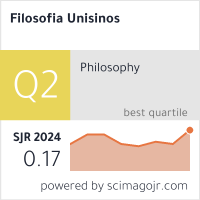On truth as the source of good: An is/ought reinterpretation
DOI:
https://doi.org/10.4013/5023Abstract
Chinese and western philosophies tend to give different answers to is/ought relation. The disputes provide a broader vision to make a reexploration into the old and fruitful question. Clear distinctions between the subjective fact judgment and the objective fact, between the subjective value judgment and the objective value are the prerequisite. A subjective fact judgment, an is statement, consists of two elements: the judging person or power, and the judged object, i.e. the objective fact. It is the judged object itself that works as the criterion for the true or false of the fact judgment. A subjective value judgment, or an ought statement, consists of three elements: the judging person or power, the judged object or the objective fact, and the third element, which is something other than the judged object and works as the criterion for the making of the good or evil judgment. The third element in the value judgment is the core in the is/ought distinction and also the source of ought. Further analyses into the third elements under different types of value judgments show that this source of ought is fundamentally and essentially factual. The relation of fitness objectively existing between the judged object and the third element is found to be the ultimate factual foundation of value judgment. A final reunification of is and ought is achieved at the factual relation of fitness while the difference between is/ought lies only in the perspectives to depict the relation. So, fundamentally, ought can only be derived from is while the good flows from the truth. Such a conclusion accepts the Chinese connection thesis between is and ought, but rejects its emphasis of good over truth.
Key words: Is/ought, two-element judgment/three-element judgment, the third element, truth/good.Downloads
Metrics
Downloads
Published
How to Cite
Issue
Section
License
I grant the Filosofia Unisinos – Unisinos Journal of Philosophy the first publication of my article, licensed under Creative Commons Attribution license 4.0 (which allows sharing of work, recognition of authorship and initial publication in this journal).
I confirm that my article is not being submitted to another publication and has not been published in its entirely on another journal. I take full responsibility for its originality and I will also claim responsibility for charges from claims by third parties concerning the authorship of the article.










